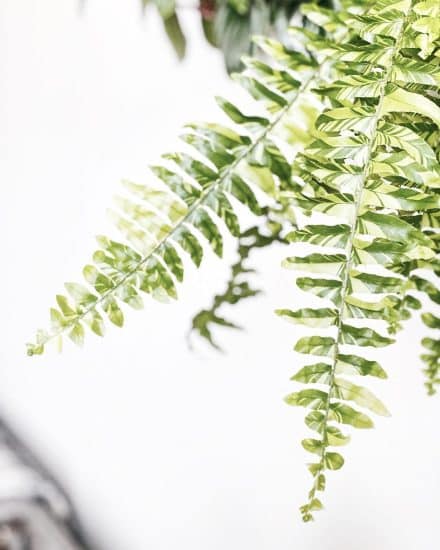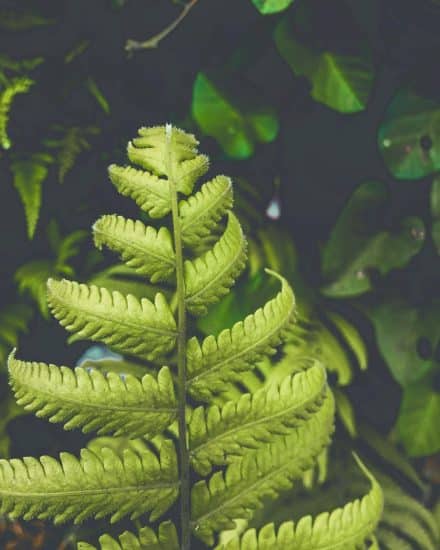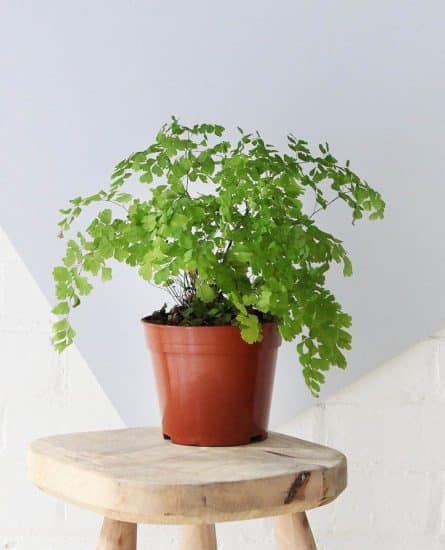Welcome to the wonderful, lush world of ferns, complete with delicate fronds and captivating shades of green.
Ever wanted to make your abode more like a serene forest filled with the rustling sounds of leaves? Adding a fern or two to your living space will make your dreams a reality.
We’ll explore everything you need to know about these graceful houseplants, from their advanced age (you might be surprised!) to the fern care requirements that’ll keep them thriving in your home.
Table of Contents
Fern Care Guide
History, Habitat, and Characteristics

Ferns have been around since before flowers even existed. Belonging to the botanical family Pteridophyta, these ancient, non-flowering beauties reproduce through spores instead of seeds.
Adaptable and versatile, ferns are found around the globe and have evolved to thrive in habitats ranging from tropical climates to cool, temperate environments. This resilience makes them a fantastic choice for plant enthusiasts of all experience levels.
Ferns might seem like delicate plants, but their history is rooted in resilience. Throughout their evolution, they’ve developed various adaptations to survive in challenging environments, including root stalks that help them draw nutrients from the ground. Plus, their natural ability to regenerate easily makes them low maintenance.
Fun fact: Ferns are among the oldest plants on Earth, with fossil records dating back over 360 million years!
Varieties

Leaf textures differ significantly among fern species. While the maidenhair fern (Adiantum sp.) boasts elegant, frilly leaves that add grace to any space, varieties like the Japanese holly (Cyrtomium falcatum) and austral gem (Asplenium australasicum) flaunt thicker, more robust foliage, making them ideal companions for those who prefer hardier houseplants.
Here are a few of the most popular varieties of fern houseplants:

Maidenhair fern (Adiantum sp.): Known for its delicate, lacy fronds and graceful growth habit, this fern is a popular choice for indoor plants and shaded garden locations. This true fern variety prefers consistently moist soil and moderate to high humidity. It is notoriously easy to kill.
Button fern (Pellaea rotundifolia): Button fern stands out among fern varieties for its round, button-like leaflets that line its arching, dark-green fronds. It can tolerate a wider range of light conditions than most ferns, making it an excellent choice for rooms with low light levels.

Boston fern (Nephrolepis exaltata): Popular among tropical ferns, this is a classic fern variety, known for its lush, green fronds that can reach up to 3 feet in length. It’s a popular choice for hanging baskets or as a stand-alone plant, both indoors and outdoors, because it’s quite hardy and resilient.
Asparagus fern (Asparagus setaceus): Despite its name, the asparagus fern is not a true fern but a member of the lily family. This plant has delicate, feathery foliage that resembles asparagus shoots, hence its name. It’s an evergreen plant with fast-growing stems that can reach up to several feet long.
Light

There are a few indoor fern species that appreciate full sun, such as the athyrium fern and the ostrich fern, but the vast majority that you’ll find in houseplant nurseries will thrive in medium to bright filtered light.
Drawing from their natural habitat, where most ferns naturally grow under dappled shade on forest floors, aim to recreate such an environment in your cozy abode. While they can tolerate low sun environments, bright indirect sun, like that found near a north-facing window, is what they need to truly flourish.
Be cautious not to expose them to direct sunlight, which can crisp or bleach their delicate leaves or cause them to turn yellow. For the best results, place your fern 6 feet from a bright window or settle it near a north-facing window.
Our lighting tips:
- Shield your fern from direct sunlight to avoid crisping and discoloration of the leaves.
- Achieve optimal lighting by positioning your fern 6 feet away from a bright window or in a north-facing window.
- Should you notice yellowing leaves, your fern might be receiving excessive light. Try relocating it to a shadier area or introduce a sheer curtain to filter the sun’s rays.
Water

Ferns are happiest when you’re able to keep the soil moist. Water your indoor fern before the soil dries out. You can use your finger to test the top inch of soil. When it starts to feel like a sponge that has been squeezed out — almost dry — it’s ready to water again.
Some fern owners swear by bottom-watering their ferns, but we haven’t experienced that it’s necessary to water them this way. As long as you keep the soil moist, not wet, and never dry, you can water from the top or the bottom, whatever works for your plant.
Pro tip: If you do water from the top, use a long-spouted can for bushy types or you risk water going everywhere.
Even with ferns, overwatering is the most common way people kill indoor plants (except maidenhair ferns, which will die for any reason). Wilting, yellowing, or falling leaves may indicate you’re giving your fern too much water. Consistently touch the soil, lift the pot to test its weight, or even use a moisture gauge to make sure the soil isn’t soggy.
Temperature and Humidity

Achieving the right balance of temperature and air humidity is key to maintaining healthy indoor ferns.
Temperature plays a significant role in growing ferns indoors. Most fern species generally prefer cooler environments. Aim for daytime temperatures between 60-75°F (15-24°C), with a slight dip at night.
Indoor ferns can suffer from heat or cold stress, leading to wilted, yellowing, or dropped leaves. Keep your ferns away from direct sun, chilly drafts, and heat sources like radiators or air vents.

Ferns love moisture, so aim for at least 45%-50% humidity, higher if you can achieve it, especially for certain fussy ferns like maidenhair. Providing consistent moisture is essential, as fluctuations might cause leaf browning or make them appear dull and droopy. Misting ferns provides only temporary relief — maintaining ongoing moisture is much more beneficial.
To increase humidity: If you want to raise a happy and healthy fern, it’s a good idea to use a humidifier, especially if you live in a dry climate. Run your humidifier a few hours a day, and if that’s not an option, keep your plant on a pebble tray consistently filled with water.
Soil and Planting

To create the perfect soil for healthy ferns, aim for a mixture that retains moisture while still allowing for proper drainage. Combining a coconut coir-based mixture with perlite or pumice can hit this sweet spot.
Ferns thrive in fresh, nutrient-rich soil, so when repotting, choose a moisture-retentive potting soil. Coconut coir holds on to moisture better than peat (and is more eco-friendly), keeping your indoor fern happy and hydrated while allowing excess water to drain.
Terracotta pots are a no-go for ferns because they absorb moisture from the soil, leaching it away from the plant’s roots. Instead, opt for cover pots filled with gravel, ceramic pots with drainage holes, or nursery grow pots to provide a healthy environment for your ferns while preventing standing water.
Fertilizer
Ferns usually need a helping of fertilizer a couple of times a year, only during the growing season. Organic liquid fertilizers like blood and bone, seaweed, fish emulsion, and worm castings are the perfect choice for feeding your ferns. Because they aren’t heavy feeders, a slow-release fertilizer low in nitrogen will serve your fern plant well.
Keep an eye out for signs of over-fertilizing, such as yellowing leaves or burnt leaf tips (a classic case of too much of a good thing!). If you suspect your ferns have had one too many helpings, flush the soil with water to remove excess nutrients and ease up on future feedings.
Propagation
Propagating ferns can be enjoyable and rewarding, allowing you to cultivate more of these delightful plants and share them with friends. There are several ways to propagate ferns, including by leaf clippings, division, and spores. We’ll cover division here.
Propagating ferns via division:
- Pick the perfect timing: The optimal time to propagate your ferns is during their active growing season, typically in spring or early summer. It’s when the plants have ample energy to grow and develop new roots.
- Gather your supplies: You’ll need a clean pair of gardening scissors or a knife, a well-draining potting mix, and some pots or containers to house your new fern babies. Make sure all your tools are spotless to prevent any disease spread.
- Gently take out the fern: Remove the fern from its pot, careful not to harm the roots. If they’re tightly packed, loosen them with your fingers or a small tool to reveal the root stalks. This is easier with moist soil.
- Divide and conquer: Now, examine the root system and locate those little root stalks. With your clean scissors or knife, cut the root system into sections, ensuring each division has both a healthy root stalk and some foliage.
- Plant your new ferns: Fill your new pots or containers with a well-draining potting mix and place each root division on top. Gently cover the roots with more mix, but keep the root stalk just above the soil surface.
- Water and wait: Give your newly potted fern divisions a good drink of water, allowing any excess to drain out. Position your new ferns in a location with bright, indirect light and high humidity to help them establish strong roots.
Common Issues

Keep a watchful eye on your plant for these common issues — we’ll tell you how to address them quickly and effectively.
Brown Leaf Edges
Brown edges on your plant’s leaves might be a sign it’s lacking humidity or receiving too much direct sunlight. When inspecting your plant, look for persistent brown areas around the edges that feel dry and brittle.
To tackle this problem, first, relocate your plant to a shadier spot without direct sunlight, keeping it comfortable and protected. Next, raise the humidity around your plant by placing a tray filled with water and pebbles under the pot or using a humidifier. Misting is fun but won’t raise the humidity enough to consistently help your plant.
Yellowing Leaves
Sometimes plants develop yellowing leaves, which might indicate they need more light, less water, more humidity, or more nutrients. To pinpoint the issue, evaluate the conditions your plant is growing in.
If you think your plant isn’t getting enough light, move it to a brighter location.
If the issue is related to watering, remember to water your plant consistently, keeping the soil evenly moist but not waterlogged. Use a pot with proper drainage and a well-draining soil mix.
To keep your plants happy, consider using a slow-release fertilizer or liquid fertilizer for added nutrients.
Pests and Diseases

Ferns are generally low-maintenance plants, but they might run into a few pesky pests and diseases occasionally.
Pests
When it comes to pests, these plants can be affected by the usual suspects: mealybugs, aphids, spider mites, fungus gnats, whiteflies, thrips, and scale. To identify these critters, keep an eye out for small bugs, webbing, or a cotton-like covering on the stems and leaves.
One simple way to prevent and manage pests is to regularly remove old fronds to keep your fern tidy. If you do notice an infestation, it’s time to act fast: isolate the affected plant from other plants, then use a damp cloth to gently wipe off the pests.
If the situation is more severe, go ahead and apply an insecticidal soap or neem oil to the leaves (and don’t forget the undersides of the fronds!).
Root Rot
Now, root rot is a common problem even for moisture-loving indoor plants like ferns. More often than not, overwatering or poor drainage is the culprit. Keep an eye out for yellowing leaves, wilting, and an unpleasant smell coming from the potting soil — these are red flags.
If you suspect rot, gently remove the plant from its pot and examine the affected area. Rotten roots will look dark, mushy, and slimy. Trim them away and repot the plant in fresh, well-draining soil, and make sure the pot has proper drainage holes.
Before you water your fern again, check the soil to make sure it’s ready. Using a moisture meter can be a game-changer to avoid overwatering in the future.
Conclusion

That’s it for our fern care and growing guide! From their ancient history to their unique evolutionary characteristics, ferns are a captivating group of indoor plants that can bring a touch of nature’s magic to your indoor space.
Fern care summary:
- Ferns prefer medium to bright, indirect light and should be shielded from direct sunlight to prevent leaf damage.
- Ideal temperatures range from 60-75°F (15-24°C) during the day, with a slight dip at night, while humidity levels should be at least 45%-50%, if not higher.
- Use a well-draining, moisture-retentive potting mix, and avoid terracotta pots, which can dry the soil too quickly.
- Feed your ferns with organic fertilizers a few times a year, keeping an eye out for signs of overfeeding.
We hope this guide has inspired you to welcome ferns into your home and care for them with confidence. If you have any further questions or need extra guidance, feel free to reach out — we’re here to help!
Take care, and happy growing!
FAQ
Do ferns like to be misted?
You will find houseplant “experts” who tell you misting is essential to discouraging pests and raising humidity. Other “experts” will tell you that misting is a waste of time. The truth is somewhere in between. While some indoor plants, like certain succulents, should never be misted, it won’t hurt your fern.
Ferns like consistently moist soil and filtered light. If you want to mist your plants, go ahead, but it’s not necessary. To discourage pests, keep your plants healthy and regularly inspect them.
The most effective way to maintain moisture in the air is to use a humidity tray or humidifier, or both.
Do ferns like a hanging basket?
Many fern varieties, such as Boston ferns and maidenhair ferns, grow beautifully in hanging baskets, adding a touch of vertical greenery and elegance to any space. Suspending your ferns allows them to cascade freely, displaying their graceful fronds in full splendor.
When picking out a basket, select one lined with coco coir or sphagnum moss to help retain moisture. Ensure it has proper drainage holes in the bottom to prevent waterlogged soil. Position the hanging basket in a well-lit area with indirect sunlight because ferns can be sensitive to harsh, direct light.



